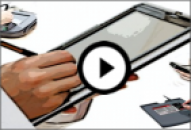The competition was organised by ICDAR, the International Conferenceon Document Analysis and Recognition, an outstanding international forum for researchers and practitioners at all levels of experience for identifying, encouraging and exchanging ideas on the state-of-the-art in document analysis, understanding, retrieval, and performance evaluation, including various forms of multi-media documents. The competition received many entries from around the world as they vied to be recognised as having the most accurate algorithms for the detection of forged handwriten signatures and simultaneously avoiding 'false negatives' from genuine signers. The detailed results were presented at the IDCAR/AFHA2011 conference in Beijing, China September 18-21, 2011.
Excerpt from the report:
The Netherlands Forensic Institute and the Institute for Forensic Science in Shanghai are in search of a signature verification system that can be implemented in forensic casework and research to objectify results. We want to bridge the gap between recent technological developments and forensic casework. In collaboration with the German Research Center for Artificial Intelligence we have organized a signature verification competition on datasets with two scripts (Dutch and Chinese) in which we asked to compare questioned signatures against a set of reference signatures. We have received 12 systems from 5 institutes and performed experiments on online and offline Dutch and Chinese signatures. For evaluation, we applied methods used by Forensic Handwriting Examiners (FHEs) to assess the value of the evidence, i.e., we took the likelihood ratios more into account than in previous competitions. The data set was quite challenging and the results are very interesting.....
...The systems participating in the IDCAR conference were evaluated by forensic experts using different testing sets. The task was to determine whether a particular signature had been written by the author of the reference signatures or if it had been forged by another writer. In all experiments, twelve known reference signatures were presented to the systems. In the test scenario the reference signatures will be enforced from outside and pre-selecting the reference set may not be allowed......
IDCAR evaluated the systems according to several measurements. They generated ROC-curves to see at which point an equal error rate was reached: i.e. the point where the false acceptance rate (forged signature being accepted as genuine) equals the false rejection rate (genuine signature being rejected). At this specific point they also measured the accuracy, i.e. the percentage of correct decisions with respect to all queried signatures.
The winner was the xyzmo solution, with the highest accuracy rates for both false acceptance rate (FAR) and false rejection rate (FRR). In comparison, the second best system had false acceptance and false rejection rates almost double that of xyzmo!
... About xyzmo SIGNificant software: The tool is based on a signature verification algorithm using statistical respectively empirical models and calculates the evidence score by comparing reference signatures and the questioned signature taking into account only features of the actual signatures without prior knowledge and does not require any training steps in advance as it is the case in other approaches. Mainly a biometric comparer is spanning a mathematical multi-dimensional room (the tolerance border) built from extracted dynamic features of the reference signatures and evaluates the distance of the questioned signature to this room by correlation methods which is then expressed and formulated into a score with a range from 0 to 1 expressing the similarity, e.g., 1 means highest similarity possible. Input parameters into the algorithm are the native signature data because extraction and comparison steps will be done internally in the comparison component when signatures are loaded for being compared. Usually the underlying algorithm supports an extra enrollment step which respectively checks which cannot be applied in the given test scenario. All signatures used as reference signatures are in the evaluated systems to fulfill defined minimum consistency criteria and a signature will be refused from entry into a profile (the set of reference signatures) in case it fails to qualify.
What results can be expected from online signature verification?
Contact Us to learn more. | 

 Connect with us on Linkedin
Connect with us on Linkedin 


 Connect with us on Linkedin
Connect with us on Linkedin 

![]()
![]()
![]()